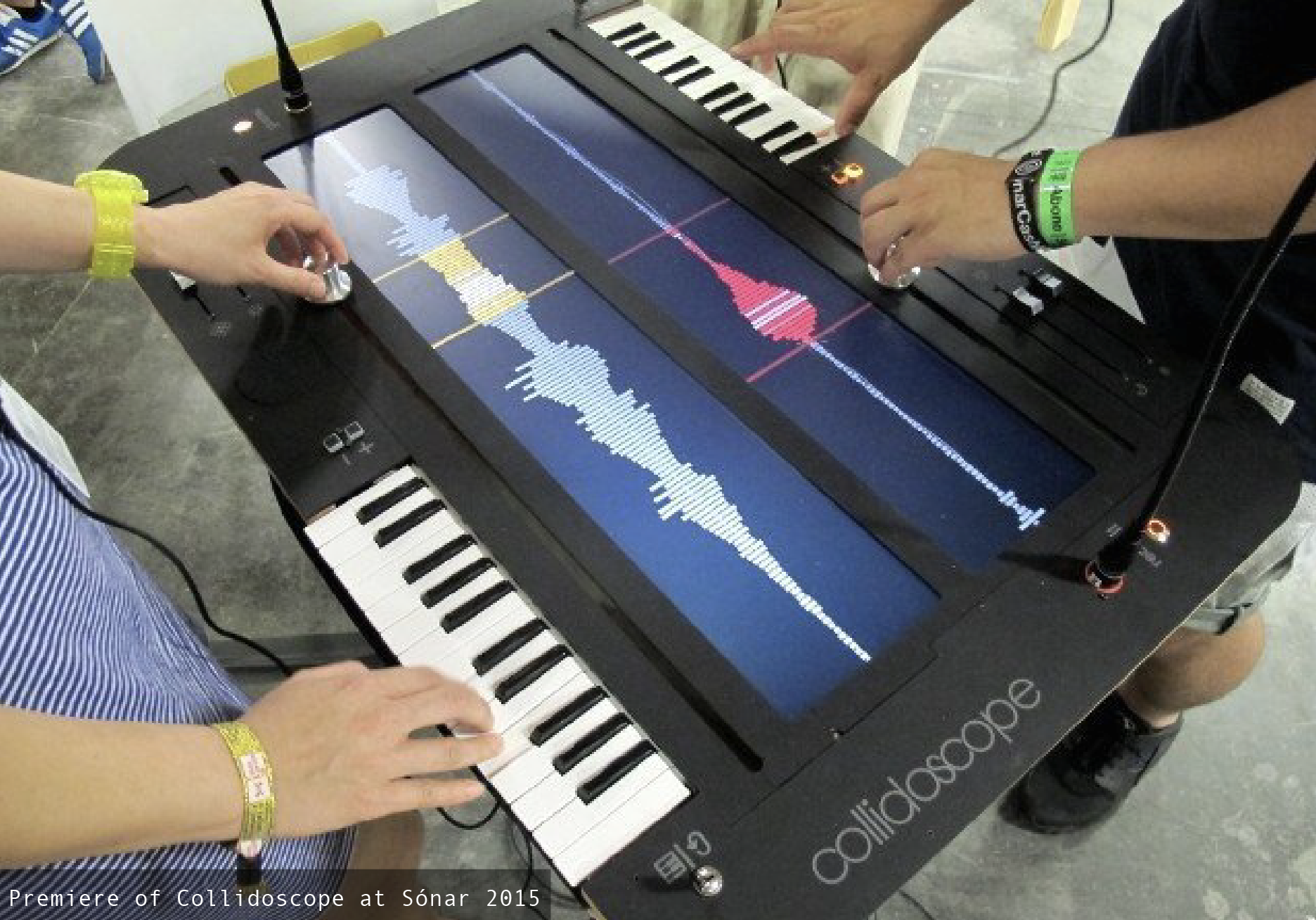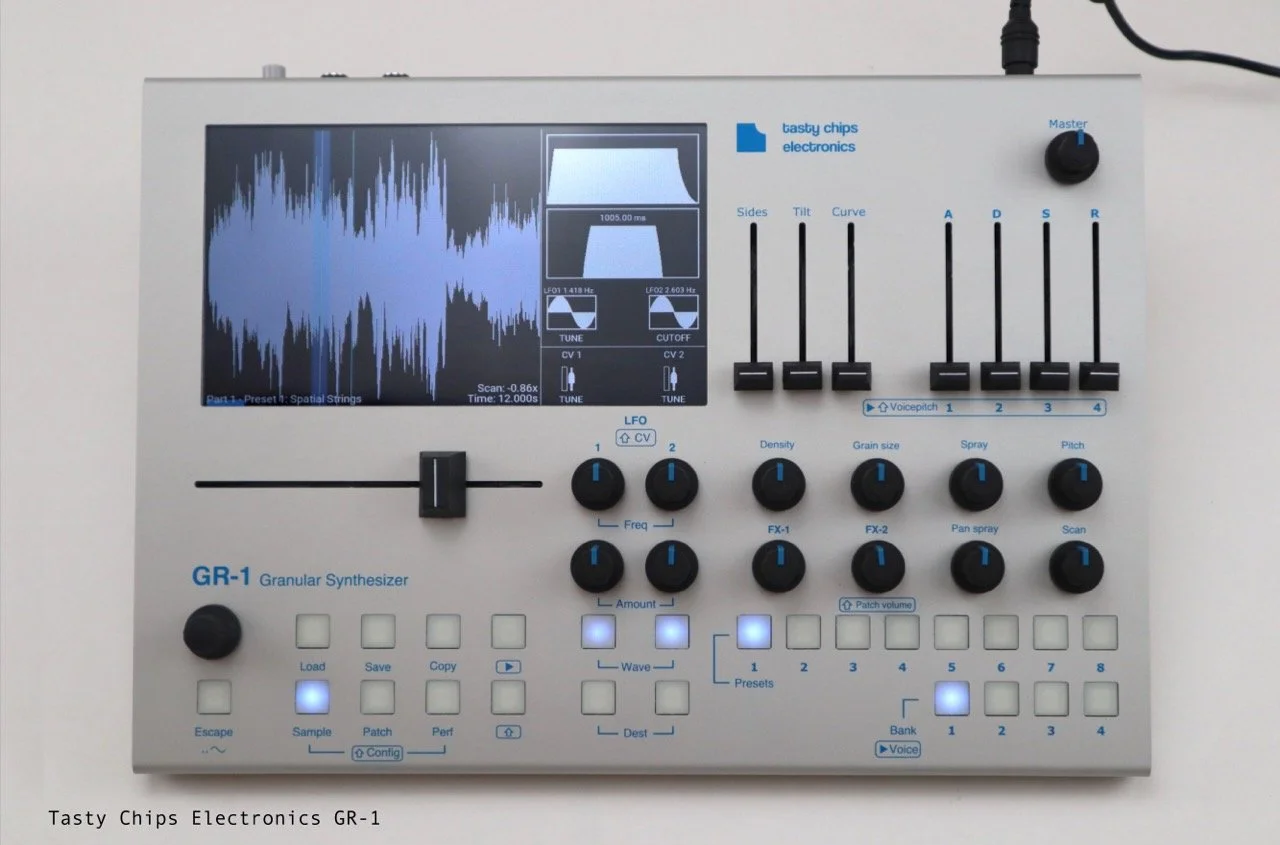2015/2025
Collidoscope 10 years on A trailblazer for hardware granular instruments.
When we launched Collidoscope at Sónar in 2015, we never imagined that it would become such a spark for granular desktop instruments, a synth type that did not yet exist at that time. Now, 10 years later, there is a wide variety of granular hardware instruments all across the range from entry-level to high-end. What makes us truly happy is knowing that Collidoscope was somewhat like a stone thrown into a magic pond with its ripples still going.
The Origins
As big fans of granular synthesis, Fiore and I started to explore how to turn this technique into a real-time performance instrument sometime in 2014. As our first attempt, we built a prototype at a Music Hack event, where you could record sounds and manipulate them via a long fabric-wrapped sensor strip with LED indication, allowing you to “slide” through the sounds in real-time. Although we liked the accessibility and flexibility of the sound manipulation, we found the required finger gesture not smooth enough and somewhat choppy.
This led to the idea of developing a mechanical slider-knob combination, allowing a “drive-through” to manipulate the sound with smooth movements and a highly tactile feel, complemented with real-time visualisations of the sound-manipulation process. A short time later, the idea of a collaborative granular instrument took shape based around this premise. From pitching Collidoscope to Sónar (only with a concept rendering), we only had about 8 weeks to make it real.
The Frenzy
After having exhibited Collidoscope at Sónar in Barcelona and the Victoria ans Albert Museum (V&A) in London throughout the summer 2015, it was the video we did with Claudio Passavanti (Doctor Mix) in November that sent things into overdrive. Reaching over 4 million views in the first 24 hours, Collidoscope "made the internet going nuts" (1). Enthusiastically received and celebrated by many, it spiralled through the internet and was picked up widely by media outlets around the globe reaching from Engadget to The Times of India. The overwhelmingly positive reception was spiced up with some typical nay-sayers reactions commenting that they could do the same with plugin xyz, or that it is certainly far too expensive for what it is. This triggered heated debates about the merits of novel physical user interfaces, tangibility, musical expression and performability - discussions that really hit home with the topics we wanted to explore with Collidoscope.
People wanted to buy Collidoscope. We even had some rather well-known artists from very different genres reaching out to us and enquiring possibilities for both live and studio use. From watching the video, many people seemed to think that the Collidoscope is something that is - at least almost - readily available for sale. Just that it wasn’t :-) We had developed Collidoscope at light speed as an one-off interactive art installation for festivals and museums, not as something that could ever be manufactured in quantity. Parts were big, custom-made and hand-assembled. However, at the peak of the frenzy a huge American online musical instruments retailer asked us how many we can deliver for the upcoming Christmas season ;-O
The Legacy
A bit overwhelmed by all of this, it took us a moment to figure out what to do. As we didn’t feel like going down the entrepreneurial route with Collidoscope, we did exactly the opposite: we released an open-source version of it that included both the hardware and software. Although we were never entirely happy with the alternative hardware implementation of the open-source Collidoscope (which we had to source out due to time constraints), Fiore’s re-writing of the original Collidoscope engine (SuperCollider) in C++ so it could run fully stand-alone on a built-in Raspberry Pi is something we are really proud of. 5 years later, electronic instrument giant KORG would switch from dedicated DSP hardware to using the generic and most of all inexpensive Raspberry Pi Compute 3 module for their 2020 Wavestate synthesiser (2) to get it into the sub-$1000 price region. KORG followed through with this approach for the consecutive Modwave, Opsix and the most recent multi/poly synthesisers (2025).
Referring to Collidoscope as its direct inspiration (3), boutique manufacturer Tasty Chips Electronics released with the GR-1 the first commercial desktop multi-grain hardware synthesiser in 2017. Also based on a Raspberry Pi, it adopted Collidoscope’s main premise of a combined wave display and slider and shrunk and simplified it into a producible package. One year later, granular synthesis also moved into Waldorfs multi-modal top-end synthesizer Quantum. However, it took a few more years before stand-alone granular instruments became as widespread as they are now.
Around the same time, another pioneering feature of Collidoscope - its dual, face-to-face interface paradigm - also made its debut on the commercial instrument market. In 2017, Dato launched Dato DUO, a playful electronic musical instrument designed specifically for two people to play simultaneously.
In the granular universe - somewhat in parallel to Collidoscope inspirational effect to desktop instruments, Mutable Instruments 2015 iconic Clouds eurorack module casted its powerful spell of granular live audio processing over the eurorack world and beyond. Then from 2021 it went in rapid succession. A multitude of granular desktop instruments came onto the market finally anchoring stand-alone granulars in the canon of hardware synthesiser archetypes.
With this almost abundance of granular hardware instruments nowadays, is there still anything new to discover? We certainly think so. Another Collidoscope maybe? Never say never.
“[in 2017] there were a lot of VSTs. There were simple 1-grain “microloop” hardware synths, and there was the Collidoscope: a landmark [..] that was highly influential for us, because it effectively combined a horizontal slider with a large sample display. The GR-1 took that idea, and made it practical. The Collidoscope’s fader, while ingenious, was totally custom and really difficult to produce.”
References:
Collidoscope in ADSR Sounds (link)
RaspberryPi & Korg Synthesizers (link)
Pieter van der Meer (Tasty Chips Electronics) on how Collidoscope was the inspiration for GR-1 (link).
Resources:
Interview: ‘How it was made’ (in ACM Interactions)
Open source version of Collidoscope can be found here.
Collidoscope 2015 website





